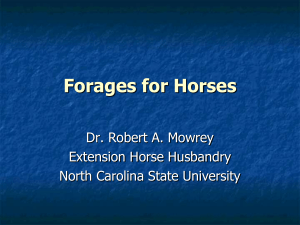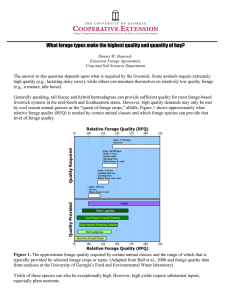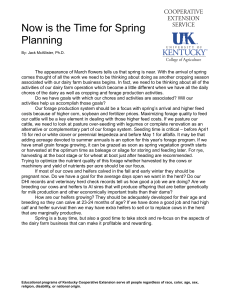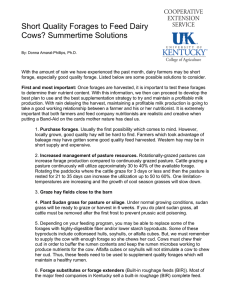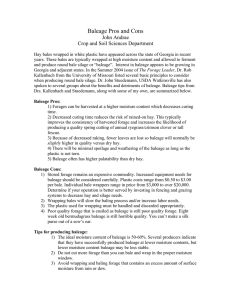UNIVERSITY OF GEORGIA College of Agricultural and Environmental Sciences
advertisement
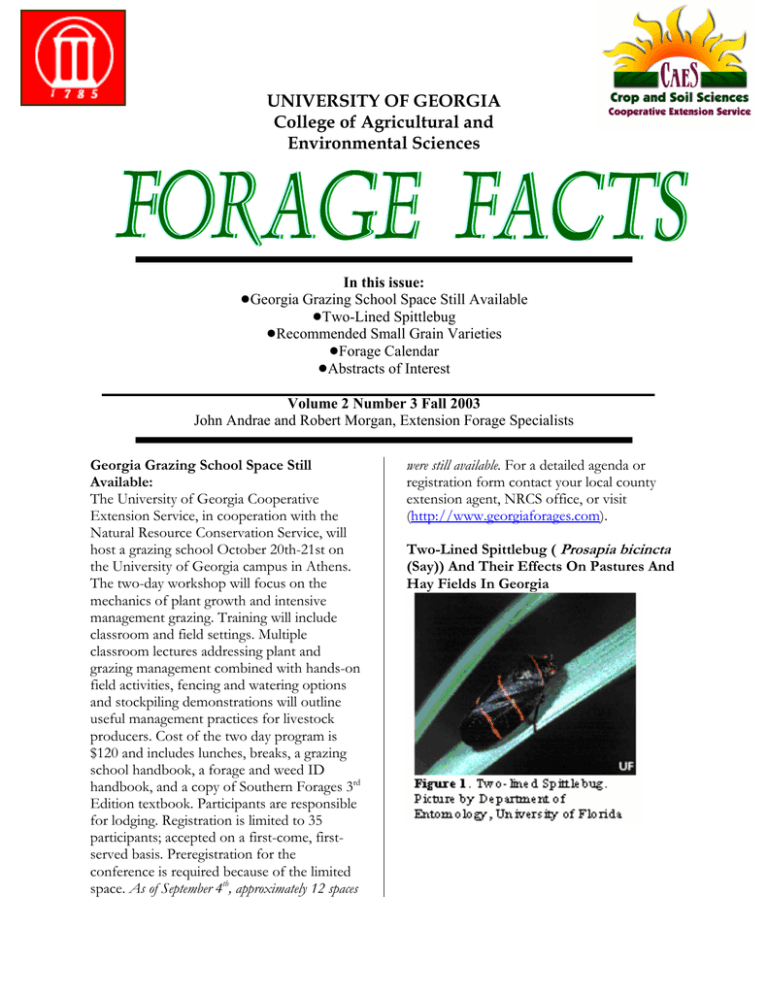
UNIVERSITY OF GEORGIA College of Agricultural and Environmental Sciences In this issue: !Georgia Grazing School Space Still Available !Two-Lined Spittlebug !Recommended Small Grain Varieties !Forage Calendar !Abstracts of Interest Volume 2 Number 3 Fall 2003 John Andrae and Robert Morgan, Extension Forage Specialists Georgia Grazing School Space Still Available: The University of Georgia Cooperative Extension Service, in cooperation with the Natural Resource Conservation Service, will host a grazing school October 20th-21st on the University of Georgia campus in Athens. The two-day workshop will focus on the mechanics of plant growth and intensive management grazing. Training will include classroom and field settings. Multiple classroom lectures addressing plant and grazing management combined with hands-on field activities, fencing and watering options and stockpiling demonstrations will outline useful management practices for livestock producers. Cost of the two day program is $120 and includes lunches, breaks, a grazing school handbook, a forage and weed ID handbook, and a copy of Southern Forages 3rd Edition textbook. Participants are responsible for lodging. Registration is limited to 35 participants; accepted on a first-come, firstserved basis. Preregistration for the conference is required because of the limited space. As of September 4th, approximately 12 spaces were still available. For a detailed agenda or registration form contact your local county extension agent, NRCS office, or visit (http://www.georgiaforages.com). Two-Lined Spittlebug ( Prosapia bicincta (Say)) And Their Effects On Pastures And Hay Fields In Georgia One of the frustrating aspects of managing pastures and hayfields in Georgia is that no matter what time of year, there is something out there to pounce on and damage your field. For this reason, it is very important that a forage manager understand these pests and how to minimize their effects on production. Last year was relatively dry (summer) and it was the armyworms, fall rains and cold weather that affected forage production well into this year. This year has been the wettest that many people can remember. One benefit is that armyworms are not showing up as a problem. But as was stated before, there are a multitude of other fungi and insects that thrive in this wet-year environment. Reports have come in all year long concerning bermudagrass pastures and hayfields with leaves turning brown and dying due to leaf spot fungi. The primary culprit has been Bipolaris spp. (previously classified as Helminthosporium fungi) but we have seen many other fungi that affect bermudagrass. But now to the point at hand; the two-lined spittlebug. Due to the wet environment, the large amount of forage and thatch (“I can’t get into my field to cut because of the rain.”), populations of two-lined spittlebugs have exploded. If you want to see one, just walk out into the centipede lawn nearest you. The two-lined spittlebug is a black insect with two reddish-orange lines across the wings (Figure 1). The adult, female spittlebug lays its eggs inside the stems of grasses. The nymphs hatch out and produce a spittle mass (figure 2) which it lives in until becoming an adult. Both the nymphs and adults have a sharp, piercing mouth which penetrates grass stems and sucks nutrients from the grass. Each inject a small amount of toxin into the plant which causes a decayed spot on the stem. A large population of these insects can cause the leaves of a field of bermudagrass to turn yellow and then die. The symptoms look very similar to a fungal leaf spot outbreak, but most of these fungi infect the leaves and not the stems or runners. This year has been a picture-perfect environment for spittlebug survival and large populations have been reported across Georgia. If the spring of 2004 turns out to be wet also, the population of spittlebugs is likely to explode and cause significant damage to pastures and hayfields. There is little that can be done at this time to control these insects. Insecticide treatments would be too expensive and not very effective in killing the nymphs and eggs. The best control treatment for spittlebugs is to burn off the pasture in early spring. Please refer to our Georgia Cattleman’s article “Prescribed Burning of Pastures and Hay Fields” (February 2002) on our web site (www.georgiaforages.com) for more information on burning pastures. The purpose of the burn is to kill the eggs of the spittlebug in the grass stems and burn off the thatch layer where the nymphs will live. Moisture is the most critical factor for maintaining the spittle mass and removing the grass and thatch layer will destroy the life cycle of this insect. Whether or not a forage manager will burn off a pasture in the spring has ramifications on the management of that field this fall. Generally, overseeding the pasture with a winter annual grass is not possible because the winter annual will be in full growth when the pasture needs to be burned. The “optimal” time for burning a pasture is one to two weeks before green-up of the field. For south Georgia this usually falls around the last week of February to the first week of March. As you move north, this date moves later in the year. The other important factor in burning off a pasture or hay field is the fuel load on the pasture at the time of burning. This grass must be grown in the fall and managed in the winter to achieve the correct fuel load. Too much fuel produces a hot fire and the stolons and rhizomes of the bermudagrass can be damaged. Too little fuel may result in an irregular burn with some eggs surviving the fire. The adult spittlebug is most active in the morning so check your fields by separating the grass and counting the adults or spittle masses you can see. If you can see adult insects or spittle masses almost everywhere you separate the grass, consider burning this pasture in the spring. The most important point is that management decisions made today concerning two-lined spittlebug and other factors will have a direct impact on the productivity of fields next year. Recommended small grain varieties. With fall rapidly approaching, it is time to begin booking and planting seed for winter grazing. The University of Georgia conducts forage variety tests for small grains and ryegrass varieties each year and recommends varieties for producers based upon a three year average of these trials. This year’s recommendations have just been published and are available in your local county extension office or online at (http://www.griffin.peachnet.edu/swvt/). There is also a direct link to this site from the Georgia Forages commodity webpage. Curt Lacy has also developed a budget for small grain forages which can be access through www.georgiaforages.com. Good rye seed is limited this year; expect high prices. The wet spring weather has also decreased germination of most available seed, so when possible buy treated certified seed. At the very minimum run a germination test at home on your seed and consider a hopper box fungicide treatment. To run a germination test, place 100 seed in a Ziploc bag with a moist paper towel. Seed should germinate in about a week. Forage Calendar: Scout for fall armyworms. This is particularly important in early planted winter annual pastures as these can be quickly wiped out by small fall armyworms. Watch for two-lined spittlebugs. See article above. Run a nutrient test on your hayparticularly the rained-on cuttings. Some of these cuttings may have higher nutrient content than you think (and vice versa). Knowing the nutrient content of hay before feeding allows supplements to be added or omitted for good animal performance. This is very cheap insurance. Soil sample all pastures. Pay particular attention to potash levels in bermudagrass fields to decrease risk of fungal diseases and improve winterhardiness. Overseed white or red clover in tall fescue, winter annuals grasses or clovers in bermudagrass/bahiagrass, establish new stands of tall fescue or orchardgrass. Again, pay attention to pH, P and K levels in the soil for good establishment results. Abstract of Interest: Nutrient composition and storage losses of bahiagrass stored as indoor hay, outdoor hay or baleage. M.E. McCormick and B.C. Venuto. LSU Southeast Research Station, Franklinton, LA. 2003 AFGC Proceedings. Baleage production appears to offer dairymen in southern Louisiana and other high rainfall areas, a relatively inexpensive means of storing high quality forage. Although annual ryegrass has been the forage of choice, an increased need for stored forage has prompted interest in using bahiagrass as a baleage crop. A study was conducted to evaluate the effect of time of day on plant sugar content in bahiagrass, our reasoning being that higher sugar content would result in superior fermentation and less mold in the bahia baleage. Sampling bahia pasture from daylight through dark revealed that sugar concentrations and plant nutritional value peaked in the afternoon between 3 and 7 p.m. A second study compared bahiagrass hay stored outdoors and in the barn to bahia stored as baleage. Outdoor-stored hay experienced high storage losses and the energy value of the forage was much lower than barn-stored bahia or baleage. Bahia baleage storage losses and nutritive value was similar to barn-stored hay. Four-week-old bahiagrass, field dried to approximately 50% dry matter and wrapped in six layers of white stretch film was found to be well preserved and retained a high percentage of the standing crop’s nutritive value after a six-month storage period. Higher costs affiliated with bahia baleage production compared to outdoor stored hay may be offset by more timely harvesting, less rain damage, and lower storage losses.
